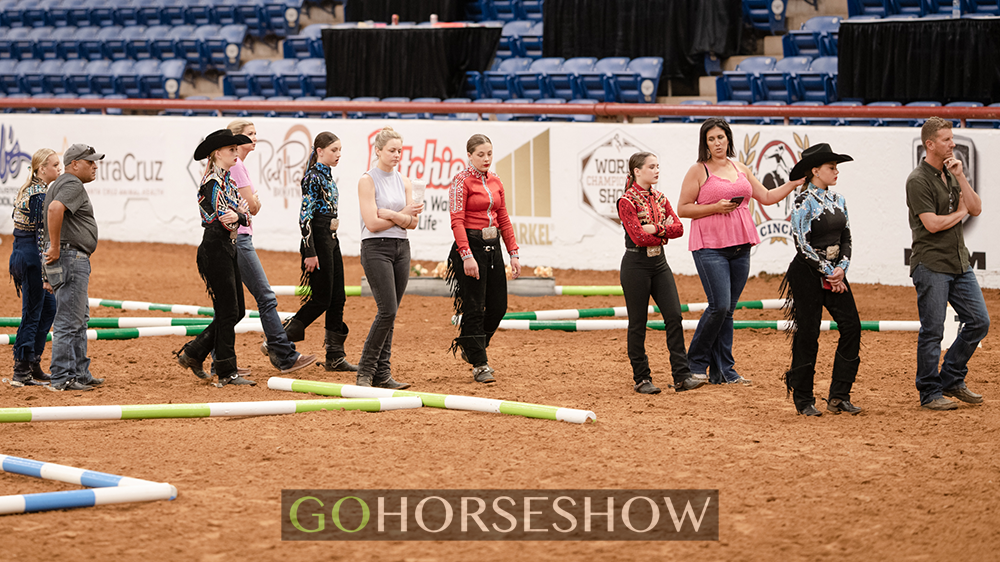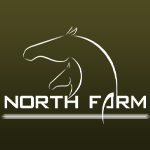While trail and hunter over fences may seem like classes on the opposite ends of the spectrum, they share at least one important trait: the ability to accurately assess the distance between obstacles and cue your horse accordingly.
We spoke with World and Congress Champion trainers Jess Bergantzel of Jess Bergantzel Show Horses and Mason Lyon of Lyon Performance Horses about their tips for accurately judging distance in trail and jumping classes.
Start Small
Both experts agree that building a proper foundation is vital to accurately assessing distance in either discipline.
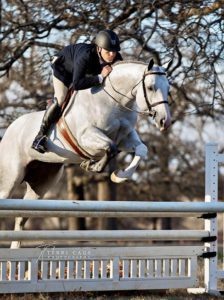 According to Lyon, he doesn’t ever start riders or horses by having them jump rails. Instead, he begins training jumpers on the ground with single canter poles (think the pole in western riding). Lyon will have riders approach the pole at different speeds and angles to help them learn to assess distance without the fear of making it over an actual jump.
According to Lyon, he doesn’t ever start riders or horses by having them jump rails. Instead, he begins training jumpers on the ground with single canter poles (think the pole in western riding). Lyon will have riders approach the pole at different speeds and angles to help them learn to assess distance without the fear of making it over an actual jump.
“Some riders will develop confidence issues with jumps or struggle with being in their head too much. So, I send them right back to the canter pole whenever that happens,” Lyon emphasizes.
Bergantzel agrees that you won’t learn how to properly assess distance in a trail course by starting off loping a fan. “When starting with a new horse or novice rider, we typically begin with just a single pole or a couple of poles. Then, we practice having the horse land 6-10 inches in front of a pole. The key to an approach isn’t the actual step over, but getting to the pole itself. If you can put them in the right spot to step, you will likely step over cleanly.”
Bergantzel believes building confidence in the approach for both the horse and the rider is imperative. The best way to do so is by taking it one pole at a time and building a strong foundation.
Rhythm Is Key
It can be tough to assess distance when your speed is constantly changing.
“Having a consistent rhythm or cadence at your canter is essential to judging distances in any jumping course,” Lyon explains. “If you are constantly speeding up or slowing down, it can be hard to determine how many strides you have to a jump because it will constantly change.”
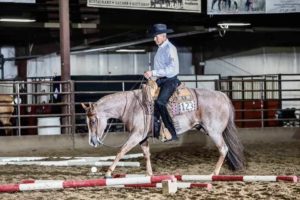 “In trail, our poles are set in three-foot increments for the trot overs and six-foot increments for the lope overs,” Bergantzel explains. “It is important to find a consistent trot rhythm that allows for a three-foot stride and a lope that allows for a six-foot stride. Getting your horse into a rhythm that translates to the pole distance is critical so that you can help your horse approach an obstacle that allows them to execute it correctly.” It is not simply about keeping a consistent pace, but finding a consistent pace that is right for the pattern.
“In trail, our poles are set in three-foot increments for the trot overs and six-foot increments for the lope overs,” Bergantzel explains. “It is important to find a consistent trot rhythm that allows for a three-foot stride and a lope that allows for a six-foot stride. Getting your horse into a rhythm that translates to the pole distance is critical so that you can help your horse approach an obstacle that allows them to execute it correctly.” It is not simply about keeping a consistent pace, but finding a consistent pace that is right for the pattern.
Be Patient
 One of the hardest lessons for amateurs can be learning patience when riding through a course.
One of the hardest lessons for amateurs can be learning patience when riding through a course.
Lyon laughs, “I can’t tell you how many times I tell my riders to, ‘Let the jump come to you,’ as they are riding a course.” Indeed, if you get too in your head about an upcoming obstacle, you are far more likely to misjudge the distance or miscue your horse due to your tension in the saddle.
Amateur trail riders are also consistently told to let the pole come to them. Bergantzel says this is a trainer telling you to “prioritize your horse’s rhythm and count each stride.” He believes it is a common mistake to want to chase your horse to the pole. Instead, he says riders need to take a breath and, “when you see the pole, count your strides, keep your rhythm, and let your horse get there.”
Walk Your Course
Both of our experts emphasize the importance of walking your course as no pattern on paper can show you the distance between obstacles or how they fit together.
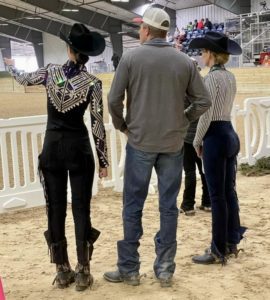 Mason and Jess advise amateurs to walk the course with their trainer and discuss sticky spots or areas to aim for before riding the pattern to best prepare for executing it properly.
Mason and Jess advise amateurs to walk the course with their trainer and discuss sticky spots or areas to aim for before riding the pattern to best prepare for executing it properly.
Lyon believes the arena itself can alter a plan. The narrower the arena, the more critical the corners become for setting up your approach for jumps. If you don’t walk the course, you can’t see these unique traits and plan accordingly.
“It is helpful to see what path to take so you have every advantage,” Bergantzel advises. He also reminds riders not only to plan where to enter the obstacles, but also to plan where to make their transitions.
“We plan our route so that we will transition in a spot where you can get in full strides to the obstacle, and there isn’t a half stride to make up for,” Bergantzel explains.
Stick to the Plan
While last-minute adjustments are par for the course for professionals, they can often result in more strife for amateurs. Once you’ve made a plan with your trainer, it’s best to stick with it.
 Lyon says that more mistakes tend to happen in jumping when riders get too “in their heads” and try to make last-minute adjustments. “Trust your plan. Trust your horse. Take a breath and ride,” Lyon advises.
Lyon says that more mistakes tend to happen in jumping when riders get too “in their heads” and try to make last-minute adjustments. “Trust your plan. Trust your horse. Take a breath and ride,” Lyon advises.
Bergantzel admits that the trail risks are a little lower, but the idea remains that sticking to the overall plan when executing a pattern is essential. He says his riders have top priorities, like rhythm, staying on the pattern, and aiming for plus maneuvers, while certain stylistic things are secondary priorities. He reminds riders to stick to the overall plan without getting too bogged down in the minutia.
Practice, Practice, and Practice More
Again, our professionals agree that practice is key to establishing your ability to assess the distance from horseback.
You can’t know what you don’t know. It may sound simple, but the best way to learn how to judge distance is to practice doing it over poles or regularly jumping from varying speeds and approaches.
Lyon believes it is essential to practice rating your horse so you learn how much control you have of their stride. For example, as you move through a course, can you slow the canter or speed up to a hand gallop and stay on course, if needed? How responsive is your horse to your cues? It may be one thing to rate speed on the rail, but can you do it in the middle of a course? All of the answers to these questions come with practice over actual obstacles.
 Bergantzel believes that depth perception can be complex, especially with head-on approaches. Therefore, the more you practice, the more accessible assessing distance will become. Jess recommends that riders video their patterns and practices to break down what works and doesn’t. This is also a helpful way to assess the difference between what a speed feels and looks like.
Bergantzel believes that depth perception can be complex, especially with head-on approaches. Therefore, the more you practice, the more accessible assessing distance will become. Jess recommends that riders video their patterns and practices to break down what works and doesn’t. This is also a helpful way to assess the difference between what a speed feels and looks like.
Practice is also essential for your horse to build their confidence in a class. Bergantzel likes to practice with his horses by collecting them up to their “spot” and then releasing them when they find it so that finding a proper placement is a reward for them. This helps train them to be a partner in making the correct approach.
Bergantzel believes, “If you keep them collected over the obstacle, there is no reward for getting to the right spot in front of the obstacle. Instead, they will likely rely completely on you to put them there instead of helping you get there.”
Know Your Horse
Finally, it is essential to know your horse as an individual. Generally, a green horse will require more guidance to get them to approach and execute an obstacle properly. Additionally, a horse with experience may help you find your spot.
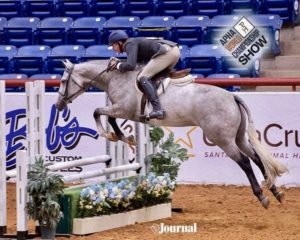 This tip is tied into practice. It is not enough to practice the discipline; it is essential to practice with your horse to learn their quirks and talents.
This tip is tied into practice. It is not enough to practice the discipline; it is essential to practice with your horse to learn their quirks and talents.
Lyon admits that he has some horses who will jump beautifully and find their spot practically on their own or even accommodate for a rider’s poor placement. However, he has others who fall apart if you don’t put them in the perfect position to make it over a jump. Therefore, knowing what your horse needs and how to best help them succeed is critical to overall success.
Bergantzel says that the individual horse makes a big difference in planning your path in a trail course. For example, if your horse is longer-strided, you will need to take a different route than if you have a short-strided horse.
Additionally, some horses are more inherently careful than others. Knowing the difference will help you practice building your horse’s confidence and teach them the proper way to execute obstacles.
If your horse needs a lot of handholding, prepare for that. On the other hand, if your horse is one you can trust, try your best not to get in their way as they approach an obstacle.


